Writing Rests #6 – Sixteenth Rest
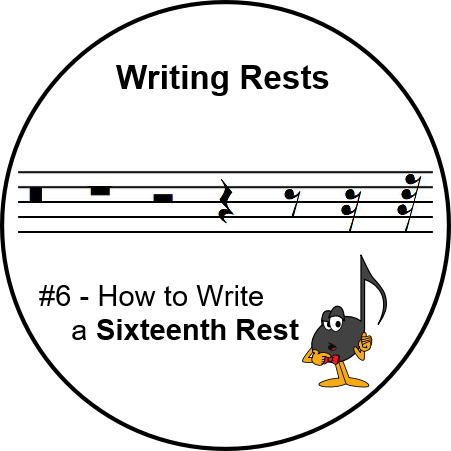
Welcome to the Ultimate Music Theory Blog Series on How to Write Rests.
- Writing Rests Blog Series #1 - How to Write a Breve Rest
- Writing Rests Blog Series #2 - How to Write a Whole Rest
- Writing Rests Blog Series #3 - How to Write a Half Rest
- Writing Rests Blog Series #4 - How to Write a Quarter Rest
- Writing Rests Blog Series #5 - How to Write an Eighth Rest
In the sixth blog in this Writing Rests Blog Series, we explore How to Write a Sixteenth Rest.
This Series explores how to write the rests properly by hand. It is not about when we write particular rests. If you have any concern, either as a Student or as a Teacher, about what rests should be used, Ultimate Music Theory has lots of ways to help:
- Teach Rhythm and Rests - This online course is perfect for giving you confidence as a Teacher. You will discover how to easily determine the division of rhythm & rests.
- Complete Music Theory Course - This online course is a great "refresher" course for Teachers and is perfect for Senior Students who wish to prepare for entrance to any Post-Secondary School for Music.
- Ultimate Music Theory Certification Course - Want to take your Teaching to the next level of Excellence? This online course will do that. Join the hundreds of UMTC Certified Teachers around the world who have expanded their Studios and their Teaching Confidence.
The Dolmetsch Online Music Dictionary says that a Sixteenth Rest is to rest one sixteenth the time value of a whole rest.
A Whole Note = 2 Half Notes = 4 Quarter Notes = 8 Eighth Notes = 16 Sixteenth Notes. Math (Fractions) and Music are so connected.
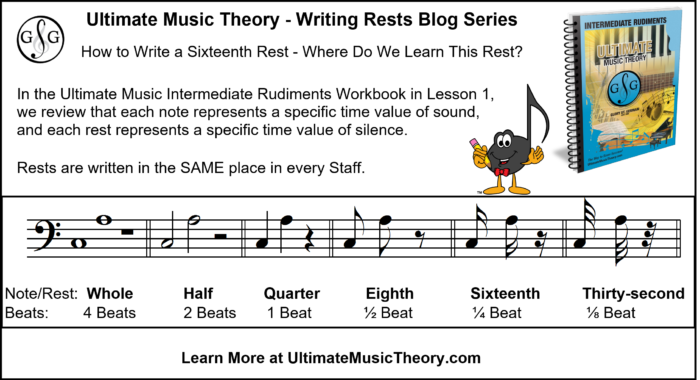
Writing Rests Blog #6 - Sixteenth Rest
Rests are an important part of music. Rhythm uses notes and rests, sound and silence.
A Sixteenth Rest is also called:
- a semiquaver rest (in England)
- a pausa di semicroma (in Italian)
- a quart de soupir (in French)
- a Sechzehntelpause (in German)
- a silencio de semicorchea (in Spanish)
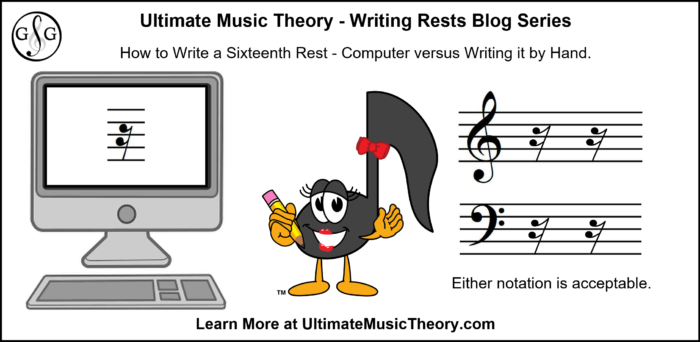
The Norton Manual of Music Notation states that "Rests should be drawn to resemble those found in engraved music as closely as possible".
Engraved Music today is typically music that is written using a Computer Program. It is actually a bit tricky to draw a Sixteenth Rest by hand so that it looks just like the Sixteenth Rest that is written using a program like Finale.
How to Write a Sixteenth Rest by Hand
A Sixteenth Rest looks like an Eighth Rest with a second hook!
There are 2 different opinions on the correct way to write the Sixteenth Rest.
- Drawing that upper line (the "hook") up to touch Staff Line #4.
- Drawing that upper line (the "hook") to end in the middle of Space #3.
Both ways are correct.
No matter where you like to end that upper hook, it cannot extend up into Space #4. The bottom of the Sixteenth Rest cannot extend down below Line #1 either.
As the Examiner for the Ultimate Music Theory Certification Course, I see so many sloppy rests. Please practice how to draw these rests! If you cannot draw them properly, you will struggle to teach your Students how to draw them properly.
We should not be sloppy Teachers! Using your Ultimate Music Theory Whiteboard is a great way to practice writing (drawing) rests correctly.
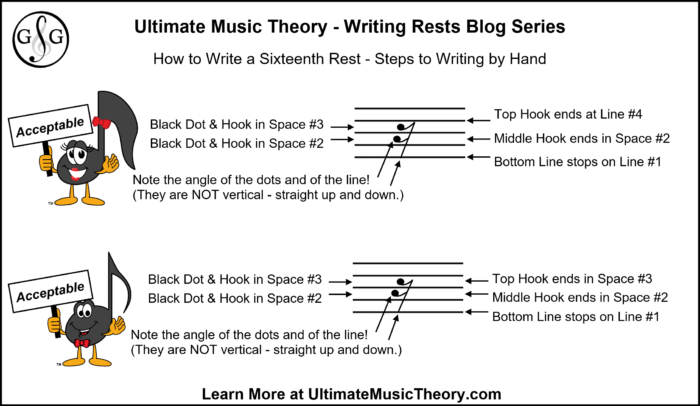
Writing Rests Blog Series 6 - Spot the Boo-Boos!
Making Boo-Boos are my superpower. I make them all the time. (My nick-name is "Boo-Boo".) As Teachers, we must support our Students to learn the proper way of writing Rests, and to help them identify (and fix) their Boo-Boos!
I've written 3 Incorrect Sixteenth Rests - can you spot the reason why they are incorrect?
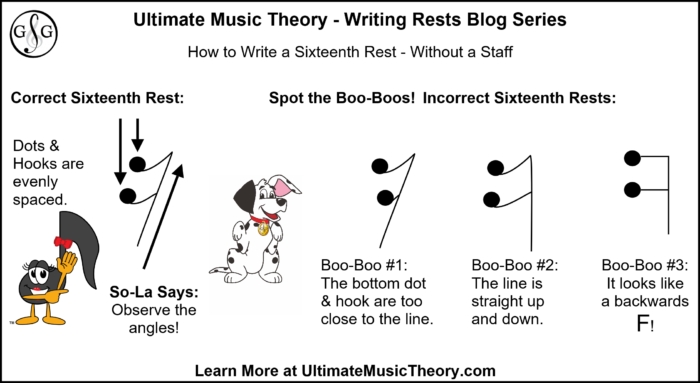
The Writing Rests Blog Series
This Blog Series will be focusing on how to write rests, and not on WHAT rest to write. Each Blog also has a matching Worksheet (with a corresponding Answer Sheet). To get these resources, join the Ultimate Music Theory Membership!
Thank you for reading! I look forward to seeing you in the Writing Rests Blog Series #7 - The Thirty-Second Rest Blog.
And, if you missed it, please remember to check out:
- Writing Rests Blog #1 - Breve Rest
- Writing Rests Blog #2 - Whole Rest
- Writing Rests Blog #3 - Half Rest
- Writing Rests Blog #4 - Quarter Rest
- Writing Rests Blog #5 - Eighth Rest
Ultimate Music Teachers Membership
♪ LEARN ♪ PLAN ♪ TEACH ♪ GROW
The One & ONLY Ultimate Music Teachers Membership
To Become A UMT PRO!
Your Success Path Starts Here - Go To TeachUMT.com Today!
Keep on Learning... With a Smile and a Song!
Shelagh McKibbon-U'Ren



Hello — I have a question. I want to write 4 16th notes, only the 2nd one is a rest — i.e. 16th note, 16th rest, 16th note, 16th note.
Which is the preferred way to write this:
1. write the 1st 16th note as a single 16th note followed by a 16th rest, followed by two 16th notes connected with a double beam, or
2. join the 1st and last two 16th notes with a double beam and write a 16th rest under the beams in the space where the 2nd 16th note would be?
Thank you!
Kiki
What a great question. Either way is perfect. If you do #2, then make certain that the stems are long enough so that your 16th rest can be written correctly. Myself, I do prefer #1 (but that is only a personal preference).